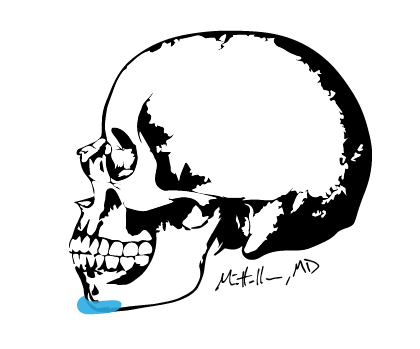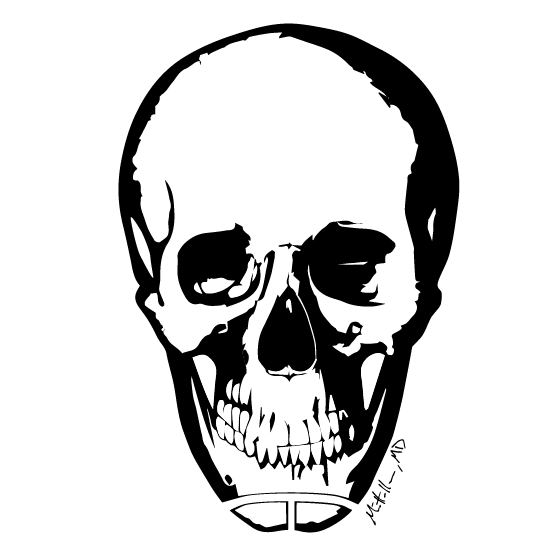
Genioplasty (Chin Surgery) – Los Angeles – Dr. Mittermiller
A genioplasty is an operation that focuses on changing the appearance of the chin. This can be done with an implant or by repositioning the bones of the chin (i.e. osseous genioplasty). Chin feminization surgery (chin FFS) is often performed as part of facial feminization surgery (What is facial feminization surgery?).
- Genioplasty (Chin Surgery) – Los Angeles – Dr. Mittermiller
- Introduction and Indications
- Surgery
- Recovery
- Frequently asked questions
- What is the difference between a chin implant and osseous genioplasty?
- How much does a genioplasty cost?
- Does insurance cover MTF chin surgery?
- Should I get a chin implant or have an osseous genioplasty for chin feminization surgery (chin FFS)?
- Can you perform a simulation of a genioplasty?
- How do I find the best genioplasty surgeon near me in Los Angeles, California?
Introduction and Indications
Why is a genioplasty (chin plastic surgery) performed?
A genioplasty (chin plastic surgery) is performed to improve the shape, size, or location of the chin. It can be performed in isolation or in combination with other procedures.
Genioplasty is commonly performed as part of facial feminization surgery for cisgender or transgender individuals. It can also be performed as part of facial masculinization surgery for cisgender or transgender individuals. Genioplasty is also commonly performed in combination with orthognathic surgery, since repositioning the teeth can sometimes require repositioning the chin to optimize aesthetic results.


What are the techniques for chin modification?
Chin augmentation with implant
A chin implant can be used when the goal is to make the chin larger or more prominent. This is commonly used for people who have a “weak” chin. The implant can be inserted either through an incision on the inside of the mouth or underneath the chin. A chin implant cannot be used to make a chin smaller. In general, men have smaller chins than women. Both men and women can benefit from chin implant placement if the chin is too far back.
Chin surgery with osteotomy (bone cuts)
A chin surgery with bone cuts is often referred to as an osseous genioplasty. This type of surgery is most commonly performed with incisions on the inside of the mouth. Bony cuts are created and the chin bone is moved into a new position. The chin bone is often secured with a metal plate and screws. The metal shows up on medical x-rays but does not cause problems with security metal detectors.
Chin augmentation with fat
There are some scenarios where only a small amount of augmentation is required. Fat can be useful in these scenarios since it is often readily available and can be injected into the chin. This is a permanent method for augmenting the chin. The fat can also sometimes be used to remove a chin dimple or chin cleft.
Chin augmentation with fillers
Filler can be used when only a small degree of augmentation is desired. Filler material can be injected in an office setting and requires minimal recovery time. The material often dissolves within 1-2 years and requires repeat injections to achieve the desired effect.
Chin augmentation with local tissue rearrangement
The soft tissue of the chin can sometimes be rearranged to increase chin projection.1 This is an uncommon method for chin modification.
Chin augmentation with osteotomy and implant
There can be certain scenarios where a significant degree of advancement is required that is too great to be achieved with any one technique. In these scenarios, an osteotomy (bone cut) can be combined with an implant to maximize the augmentation effect.
Surgery
How is a chin implant placed?
Chin implants are frequently placed through an incision on the inside of the lower lip. The bone of the chin is exposed and a chin implant is placed on top of the bone to augment the chin. The implants are commonly made of silicone or porous polyethylene (such as Medpor). The incision is then closed after the implant has been placed and positioned. There are multiple shapes of chin implants that can be used depending on the starting shape of the chin and the desired outcome.
Instead of placing an incision within the mouth, some surgeons will make an incision underneath the chin to reduce the risk of infection. The downside is a more visible scar.



How is an osseous genioplasty performed?
There are multiple types of osseous genioplasties that can be performed. The simplest involves a single cut that goes across the chin. There is a nerve at the lower part of the chin (mental nerve) that supplies sensation to the lower lip and chin. It is important for this nerve to be protected during the operation. A basic sliding osseous genioplasty is performed by creating a cut through the chin in a fashion similar to the illustrations below.
This cut allows the surgeon to separate the chin from the remainder of the jaw (mandible).
The chin is then free to be positioned in the desired location. It is held into place using plates and screws. Once it is placed into the desired location, additional contouring can be performed to smooth any transition points. With time, bone will grow in the location of the cut, provide long-term healing, and further improve the contour of the cuts.





What is a T-shaped genioplasty (chin reduction surgery) for chin feminization surgery (chin FFS)?
A T-shaped genioplasty is a type of osseous genioplasty that is used to reduce both height and width of the chin. This is commonly used for chin FFS during facial feminizataion surgery.
As with all osseous genioplasties, the soft tissues of the chin are separated from the bone of the chin. The cuts in the bone are then designed in the shape of a T. The horizontal cuts allow the height of the chin to be reduced. The vertical cuts in the bone allow the width of the chin to be reduced. The chin reduction surgery is performed by removing the middle segment of bone from the vertical and horizontal segments.





Recovery
How is the recovery after a genioplasty?
It is generally recommended to take a week off work to allow for recovery. Complete recovery takes roughly one month and there may be residual swelling that lasts up to 1 year following the operation.
Sutures are placed at the end of the procedure, and these will take multiple weeks to dissolve on their own.
There will likely be swelling and bruising following the procedure. A compressive dressing is usually applied at the end of the procedure that assists with swelling.
A chin implant generally has a faster, less painful recovery since less surgical manipulation of the chin is required in comparison to an osseous genioplasty.
Due to manipulation around the mental nerve, it is common for patients to have numbness of the lower lip immediately after the operation that improves over time.
Tooth brushing may begin immediately following the operation, but patients should be particularly careful with the front, lower teeth to prevent putting pressure on the incision.
Patients may begin eating immediately following a genioplasty, but they should limit themselves to soft foods at first to prevent disruption of the incision.
What are the risks of a genioplasty?
The risks of a genioplasty depend on the specific type of chin surgery being performed.2
One of the greatest risks involved with a chin implant or osseous genioplasty is injury to the nerves (mental nerves) that supply sensation to the lower lip. Other infrequent complications include opening of the incision, infection of the implant or hardware (plates and screws), incorrect positioning of the chin, or chin ptosis (droopiness of the soft tissue of the chin).
A risk specific to chin implants is gradual erosion of the bone underneath the implant, resulting in loss of projection of the chin. If the chin is not secured during the operation, there is a possibility that the implant will be slightly mobile even after complete healing.
A risk specific to the osseous genioplasty is incomplete healing of the cut through the bones of the chin.
Frequently asked questions
What is the difference between a chin implant and osseous genioplasty?
A chin implant can be used in situations where the goal is to augment, or add volume, to the chin. This can be done to increase the width or forward projection of the chin. It is generally performed for people who have a particularly “weak” chin.
An osseous genioplasty provides more opportunities for modifying the chin. It has similar indications as a chin implant but is more versatile. It can be performed for people who have a “weak” or “strong” chin. It can make a chin taller or shorter, wider or narrower. It can move the chin forward or backward. It can be performed with jaw contouring to create a V-line jaw. It can also be used to improve asymmetries of the chin.
An osseous genioplasty is more commonly performed for chin FFS as a part of the facial feminization surgery process since FFS chin surgery commonly involves creating a smaller, more petite, rounded, pointed chin.
How much does a genioplasty cost?
Osseous genioplasties are generally more expensive than genioplasties that use only an implant. The cost often depends on whether additional procedures are being performed along with the genioplasty and whether insurance is covering the procedure.
Genioplasty – According to a RealSelf article written in 2020 and updated in 2022, the average cost for a genioplasty is $7,725 with a range from $200 to $25,000. (https://www.realself.com/surgical/genioplasty)
Chin implant – According to a 2021 article by RealSelf that was updated in 2022, the average cost for a chin implant is $4,950 and it can cost as much as $11,025. (https://www.realself.com/surgical/chin-implant/cost)
Does insurance cover MTF chin surgery?
There are insurances that will cover the cost of MTF chin surgery for transgender patients who are experiencing gender dysphoria and who have appropriate documentation. It is important to see a facial feminization surgeon who has experience with FFS chin surgery to discuss this possibility.
Should I get a chin implant or have an osseous genioplasty for chin feminization surgery (chin FFS)?
This is a complicated question that has many individualized factors.
A chin implant can be the right decision for somebody who needs only augmentation (increase in length, height, or width) and is interested in a quick recovery and lower cost.
An osseous genioplasty is necessary for individuals who need reduction of the chin in a vertical or horizontal dimension. This is often the movement that is performed for chin feminization surgery. It is also necessary for patients who need the chin moved backward. For patients who need chin augmentation and want to minimize foreign material in their body, the osseous genioplasty is the right decision.
Can you perform a simulation of a genioplasty?
We will be able to perform a photo simulation of a genioplasty at the time of your consultation. Certain modifications of the chin (e.g. advancement or setback) are easier to simulate than others.
How do I find the best genioplasty surgeon near me in Los Angeles, California?
Genioplasties are commonly performed by multiple types of surgeons in Los Angeles. One can have chin surgery in Los Angeles by an oral and maxillofacial surgeon, plastic surgeon, and facial plastic surgeon. Plastic surgeons with specialty training in craniofacial surgery have undergone additional training to operate on the bones of the facial skeleton. It is important for patients to research potential surgeons in Los Angeles and find one who fits well with their needs.

Dr. Mittermiller is a plastic surgeon with training in aesthetic and reconstructive surgery and specialty training in craniofacial surgery
Contact us today for a consultation.
- Viterbo F, Brock RS (2013) Gliding mentoplasty: a new technique. Aesthetic Plast Surg 37 (6):1120-1127. doi:10.1007/s00266-013-0226-x https://www.ncbi.nlm.nih.gov/pubmed/24142115
- Oranges CM, Grufman V, di Summa PG, Fritsche E, Kalbermatten DF (2022) Chin Augmentation Techniques: A Systematic Review. Plast Reconstr Surg. doi:10.1097/PRS.0000000000010079 https://www.ncbi.nlm.nih.gov/pubmed/36729154